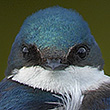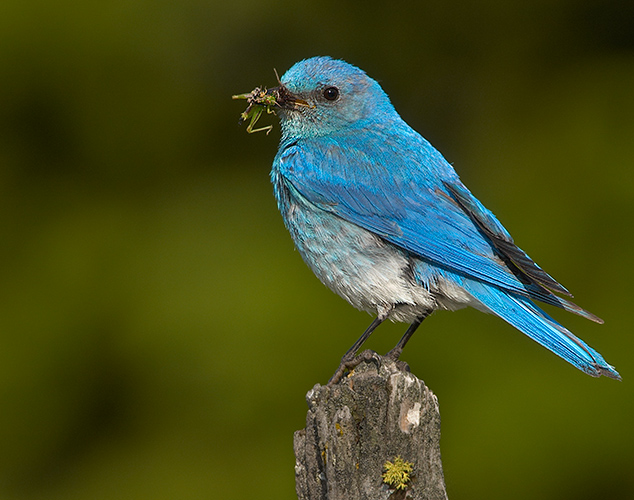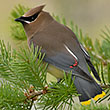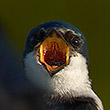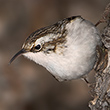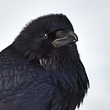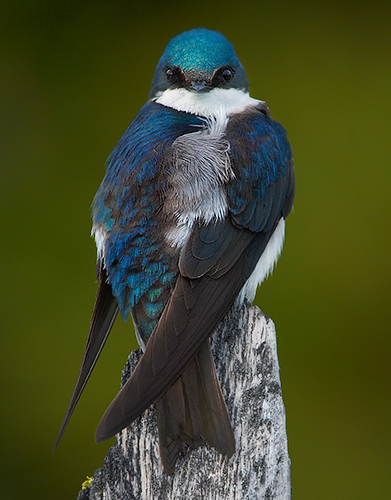
Availability: Limited Edition Print; RM Stock (??)
In the Field
Intensity - Defined! Findlay Creek, BC, Canada. May 17, 2007.
Songbirds should always be photographed in direct, frontal sunlight - right? Wrong! Many species of birds, including songbirds, have iridescent plumage that not only shifts in colour when seen from different angles but also reflects light directly back to the source. This can mean that under bright frontal light ALL you see is an extremely high contrast version of the bird - exceptionally dark darks and exceptionally white whites and, most importantly, almost no colour. I captured this stunning breeding Tree Swallow when the angle defined by the sun-to-the-bird and the bird-to-me was about 20 degrees. And, more importantly, the sun was "filtered" by a moderately thin cloud cover, which provided enough light for the iridescent colours to "shine" but not so much light that all colour was blown out. I also used a very light fill flash to open up some of the shadows on the bird, particularly in the region around the eyes. The fill flash had no impact on the iridescence or colour of the bird. It's instructive to compare the colour characteristics of the image above to that of another Tree Swallow shot under full, unfiltered sunlight.
Another thing contributed to the colour characteristics of this bird when I shot this image - its behaviour! This bird had been "preening" (cleaning/straightening its feathers with its bill) for 5 to 10 minutes and had separated the feather barbs and barbules maximally, which dramatically increased the impact of the reflectance and hence the iridescence of the plumage. Once the bird completed its preening I shot a number of images, but this was the only one where the bird turned and stared directly at me (for a millisecond!). Luckily I reacted quickly enough and I captured the "head-on" stare - this shot ended up being my favourite of the lot.
One final comment on this image. It represents an "off-target" capture in that I was working on photographing a pair of breeding Mountain Bluebirds when I captured this image. Normally I'm hesitant to move off my primary subject when shooting, but sometimes you just have to go with what you're given. Given the light, the bird's behaviour, and the fact that I was completely set to go, I just couldn't let this opportunity slip away!
Behind the Camera
Intensity - Defined! Findlay Creek, BC, Canada. May 17, 2007.
Digital Capture; Uncompressed RAW (NEF) format; ISO 160.
Nikon D2Xs with with Nikon 200-400 mm f/4G ED-IF AF-S VR lens @ 400 mm paired with 1.4X Nikon TC-14E II teleconverter (825 mm equivalent with digital conversion factor) supported on Gitzo 1348 carbon fibre tripod with Wimberley head. VR turned to "On" and in "Normal" mode. SB-800 flash (fill) with Better Beamer Flash Extender mounted on Really Right Stuff flash bracket.
1/100s @ f10; -1.0 stop exposure compensation from matrix-metered exposure setting; balanced i-TTL flash exposure with -1.0 stop compensation on SB-800.
At the Computer
Intensity - Defined! Findlay Creek, BC, Canada. May 17, 2007.
RAW Conversion to 16 bit TIFF, including first-pass sharpening, exposure compensation, and tone curve adjustment, using Phase One's C1 Pro. Multiple RAW conversions (2 at different exposure settings) to extend dynamic range of captured image, in this case primarily to restore shadow detail in the eye region of the bird.
Further digital correction on 16-bit TIFF file using Adobe's Photoshop CS3 and LightZone 2.3. Tonal adjustments performed in LightZone (using the ZoneMapper tool). Photoshop adjustments included tone curve adjustment, compositing and masking of different exposure versions AND different tonal versions (original plus version produced using LightZone), selective saturation enhancement, selective application of warming filter, selective noise reduction (using Picture Code's Noise Ninja plug-in), and selective sharpening for web output.
Conservation
Intensity - Defined! Findlay Creek, BC, Canada. May 17, 2007.
Ten percent of the revenue generated by this image will be donated to Wildsight.
Species Status in Canada*: This species is not designated as at risk.
The Tree Swallow (Tacycineta bicolor) is a common insect-eating aerobatic specialist found across much of North America. Tree Swallows nest in abandoned cavities in trees or in nest boxes provided for them by humans. The breeding range of the Tree Swallow is expanding southward and overall their populations appear to be increasing.
This male Tree Swallow was photographed in the Columbia Valley of the East Kootenays. While this species is not considered at risk in any way, many ecosystems within the Columbia Valley face development pressure. Wildsight is an effective conservation organization that protects biodiversity and promotes sustainable communities in Canada's Columbia and Rocky Mountains. Support for Wildsight, through donation or becoming a member, will help ensure that they remain effective in their efforts to conserve threatened or endangered species and ecosystems.
*as determined by COSEWIC: The Committee on the Status of Endangered Wildlife in Canada



















